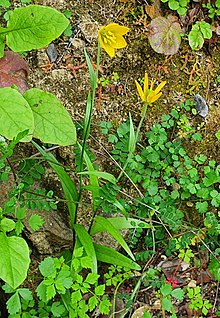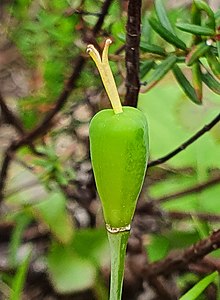
Fritillaria imperialis, the crown imperial, imperial fritillary, Kaiser's crown, or Kurdish tulip is a species of flowering plant in the lily family Liliaceae, native to a wide stretch from the Anatolian plateau of Turkey, Iraq and Iran to Afghanistan, Pakistan, Northern India and the Himalayan foothills. It is also widely cultivated as an ornamental and reportedly naturalized in Austria, Sicily, and Washington State, USA. The common names and also the epithet "imperialis", literally "of the emperor", refer to the large circle of golden flowers, reminiscent of an emperor's crown.
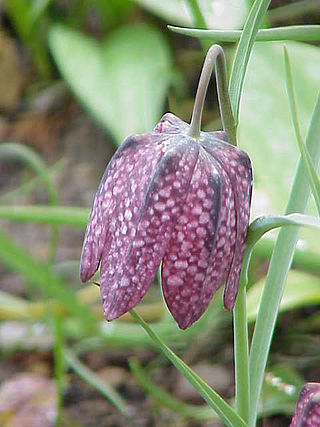
Fritillaria (fritillaries) is a genus of spring flowering herbaceous bulbous perennial plants in the lily family (Liliaceae). The type species, Fritillaria meleagris, was first described in Europe in 1571, while other species from the Middle East and Asia were also introduced to Europe at that time. The genus has about 130–140 species divided among eight subgenera. The flowers are usually solitary, nodding and bell-shaped with bulbs that have fleshy scales, resembling those of lilies. They are known for their large genome size and genetically are very closely related to lilies. They are native to the temperate regions of the Northern hemisphere, from the Mediterranean and North Africa through Eurasia and southwest Asia to western North America. Many are endangered due to enthusiastic picking.

The lily family, Liliaceae, consists of about 15 genera and 610 species of flowering plants within the order Liliales. They are monocotyledonous, perennial, herbaceous, often bulbous geophytes. Plants in this family have evolved with a fair amount of morphological diversity despite genetic similarity. Common characteristics include large flowers with parts arranged in threes: with six colored or patterned petaloid tepals arranged in two whorls, six stamens and a superior ovary. The leaves are linear in shape, with their veins usually arranged parallel to the edges, single and arranged alternating on the stem, or in a rosette at the base. Most species are grown from bulbs, although some have rhizomes. First described in 1789, the lily family became a paraphyletic "catch-all" (wastebasket) group of lilioid monocots that did not fit into other families and included a great number of genera now included in other families and in some cases in other orders. Consequently, many sources and descriptions labelled "Liliaceae" deal with the broader sense of the family.

Fritillaria affinis, the chocolate lily, is a highly variable species of flowering plant in the lily family Liliaceae native to western North America.

Fritillaria uva-vulpis, commonly called the fox's grape fritillary, is a bulbous perennial plant belonging to the genus Fritillaria and native to eastern Turkey, north-western Iraq and western Iran. They are mainly found in the wooded foothills of the Zagros, where they grow in damp meadows and cornfields between 900 and 1800 m above sea level.
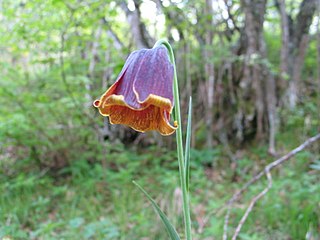
Fritillaria pyrenaica is a species of flowering plant in the lily family Liliaceae, native to the Pyrenees in Spain and France. Common names include Pyrenean fritillary and Pyrenean snake's-head. It is a bulbous perennial growing to 45 cm (18 in). The pendent, bell-shaped flowers are borne in spring. They have recurved tepals which are purple tinged with brown and yellow. Like other species in this genus, notably F. meleagris, they are strongly chequered.

Fritillaria verticillata is a flowering plant in the lily family Liliaceae, native to Japan, Korea, Mongolia, Xinjiang, Kazakhstan and the Altay region of Siberia.
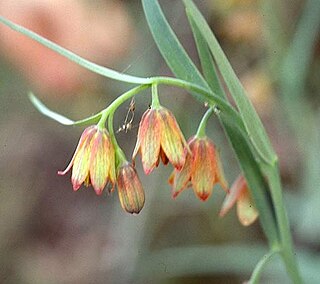
Fritillaria eastwoodiae, also known as Butte County fritillary or Eastwood's fritillary is a rare member of the Lily family (Liliaceae), native to the foothills of the northern Sierra Nevada, and Cascade Mountains in California and southern Oregon, USA.

Calochortus albus is a North American species in the genus Calochortus in the family Liliaceae. It is also known by the common names fairy lantern, white fairy lantern, pink fairy lantern, lantern of the fairies, globe lily, white globe lily, white globe-tulip, alabaster tulip, Indian bells,satin bells, snowy lily-bell, and snow drops.

Fritillaria purdyi, the Purdy's fritillary, is a rare species of flowering plant in the lily family Liliaceae.
Fritillaria viridea is a rare species of flowering plant in the lily family Liliaceae, known by the common name San Benito fritillary. It is endemic to the Central Coast Ranges of California, USA, where it belongs to the chaparral and serpentine soils flora. There are confirmed records of this species from San Benito and Monterey Counties plus unconfirmed reports from Fresno and San Luis Obispo Counties.
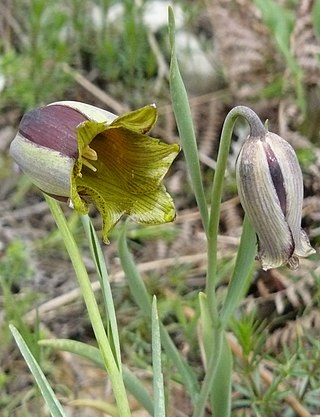
Fritillaria acmopetala, the pointed-petal fritillary, is a species of flowering plant in the lily family Liliaceae, native to rocky limestone mountain slopes in the Middle East. It was described by the Swiss botanist Pierre Edmond Boissier in 1846.
Fritillaria cirrhosa, common name yellow Himalayan fritillary, is an Asian species of herbaceous plant in the lily family, native to China, the Indian Subcontinent, and Myanmar.

Fritillaria messanensis is a European species of flowering plant in the lily family Liliaceae, native to southeastern Europe: Italy, Greece, Albania, former Yugoslavia.
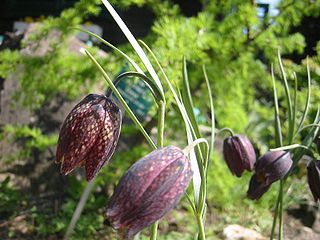
Fritillaria montana is a European species of flowering plant in the lily family Liliaceae, native to southern and eastern Europe: France, Italy, Greece, Austria, Hungary, Yugoslavia, Albania, Bulgaria, Romania, Ukraine, European Russia.
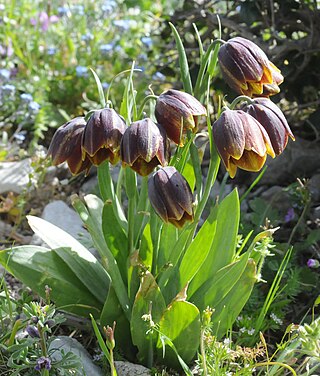
Fritillaria rhodocanakis is a species of plant in the lily family Liliaceae. In its pure form, it is found only on Hydra Island and on small neighboring islands in Greece. Additional populations occur in the Peloponnisos region of mainland Greece, though the specimens there show some degree of hybridization with F. spetsiotica and F. graeca. In 1987, some of the hybrids were described with the name Fritillaria rhodocanakis subsp. argolica, but this is now generally referred to as Fritillaria × spetsiotica Kamari.

Fritillaria assyriaca is a bulbous herbaceous perennial plant occurring in a region stretching from Turkey to Iran. It is a species in the genus Fritillaria, in the lily family Liliaceae. It is placed in the subgenus Fritillaria.

Fritillaria raddeana is a perennial herbaceous bulbous plant, distributed in Iran, Turkmenistan and Kashmir. It is a species in the genus Fritillaria, in the lily family Liliaceae. It is placed in the subgenus Petilium. Resembling Fritillaria imperialis, but shorter, it is sometimes referred to as the dwarf crown imperial.

Fritillaria dagana is a rare bulbous herbaceous perennial plant native to Siberia, Russia. It is a species in the genus Fritillaria of the family Liliaceae. It is placed in the subgenus Liliorhiza.

Fritillaria japonica is a perennial herbaceous bulbous plant, endemic to Japan. It is a species in the genus Fritillaria, in the family Liliaceae. It is placed in the subgenus Japonica.
